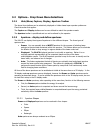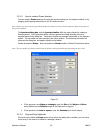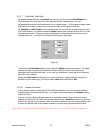
• Type in the new camera pixel scale value.
• Verify that the Pixel Units are set correctly, change as required.
• Double-click inside the Camera type edit text control.
• Type in a new 8 character file name. The .cam extension will automatically be added if
you fail to include it.
• Click on Save CAM...
• If the file path and name specified is correct, click OK.
• You will return to the Camera dialog box. Click OK.
Your new camera is now active, and saved as a <camera>.cam type file.
Note: You may now also want to perform a Save Config... operation, so that when you restart the LBA-PC
application, this new camera setup will automatically be restored. Otherwise, you must return to the Camera
dialog box and select this camera type each time you restart the LBA application.
Notice: A Restore Config... operation will occur each time the LBA application is started. Camera type selections
will only occur when you the operator consciously, unconsciously, but not sub-consciously..., make a choice. Which
ever of the above actions occurs last, is the one that is controlling the Camera dialog box settings.
3.2.3.3 Resolution and Frame Size
The Resolution value specifies how finely the incoming video image is to be digitized. This will
also determine the maximum frame size when viewing an un-zoomed image. The Resolution
value is not related to the resolution performance of your camera.
The smaller the Resolution value, the higher the resolution of the display, and the greater the
number of pixels that will be contained in the un-zoomed image. Consequently, each frame will
take more memory in the frame buffer and on disk, and it will take longer to process the frames,
thus the system will run slower.
The Resolution value will control how much memory is allocated for each frame. This figure does
not change dynamically as you zoom in. In other words, if you set the resolution to 1x, a frame
size of 512x480 is reserved in memory for each frame that is digitized. If you then hardware
zoom in twice, to a frame size of 128x120, you will be wasting 93.75% of each reserved frame
buffer locations space, since a 120x128 image is only 1/15th the size of a 512x480 image.
Thus, you should never specify a resolution that is more than what you need to do the job at
hand. Otherwise, you will waste system resources and reduce your overall throughput.
Analog camera image sizes are fixed to resolution values per the following table:
Resolution
value
Max Frame Size... WxH
(un-zoomed)
≅ Number of frames
in 8 Mb of memory
Full 1x Hor. Size X Vert. Size n.a
1x 512 X 480 16
2x 256 X 240 64
4x 128 X 120 256
8x 64 X 60 512
16x 32 X 30 2048
Operator’s Manual LBA-PC
Doc. No. 10654-001, Rev 4.10
53


















